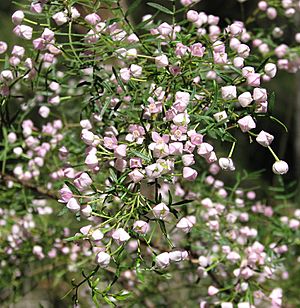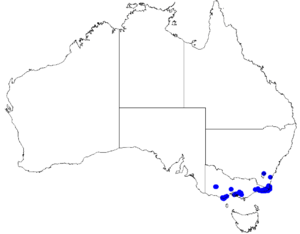Forest boronia facts for kids
Quick facts for kids Forest boronia |
|
|---|---|
 |
|
| Boronia muelleri, Bunyip State Park, Victoria | |
| Scientific classification | |
 |
|
| Occurrence data from Australasian Virtual Herbarium | |
| Synonyms | |
|
Boronia pinnata var. muelleri Benth. |
The Forest Boronia (Boronia muelleri) is a beautiful flowering plant. It grows as a woody shrub or small tree. You can find it in forests, woodlands, and heath areas. It lives in Victoria and New South Wales, Australia. This plant has special leaves that are divided into smaller leaflets. It also has pretty pink to white flowers. These flowers have four petals and bloom in spring and summer.
Contents
What Does Forest Boronia Look Like?
The Forest Boronia is a sturdy shrub or small tree. It can grow from about 0.8 to 3 meters (about 2.5 to 10 feet) tall. Its small branches have warty bumps called glands. The leaves have a nice smell. They are pinnate, meaning they are divided into smaller leaflets, like a feather. Each leaf has between seven and seventeen leaflets. The whole leaf is about 45 to 70 mm long and 20 to 45 mm wide. It sits on a stalk called a petiole, which is about 6 to 12 mm long.
The leaflet at the very end of the leaf is narrow and oval-shaped. It is about 4 to 24 mm long and 1 to 3.5 mm wide. The leaflets on the sides are similar but usually a bit longer.
Forest Boronia Flowers and Fruit
The flowers of the Forest Boronia grow in groups of up to fifteen. They appear where the leaves meet the stem. Each flower group has a stalk called a peduncle, about 4 to 15 mm long. The flower has four small, egg-shaped or triangular green parts called sepals. These sepals are smooth, about 1.5 to 2 mm long.
The four petals are the showy parts of the flower. They can be pale pink, deep pink, or white. They are about 4.5 to 7.5 mm long. Inside the flower, there are eight stamens, which are the parts that produce pollen. These stamens are hairy.
Forest Boronia mainly flowers from August to February. After flowering, the plant produces a fruit. This fruit is a smooth, dry capsule. It is about 3 to 4 mm long and 1.5 to 2 mm wide.
How Forest Boronia Got Its Name
The Forest Boronia was first officially described in 1863. A botanist named George Bentham gave it the name Boronia pinnata var. muelleri. He wrote about it in a book called Flora Australiensis. His description was based on plants collected by Ferdinand von Mueller. These plants were found near the Bunyip River, in the Grampians, near Portland Bay, and close to the Glenelg River.
Later, in 1924, another botanist named Edwin Cheel decided that this plant was special enough to be its own species. So, he changed its name to Boronia muelleri. The second part of its name, muelleri, honors Ferdinand von Mueller, the person who first collected the plant specimens.
Where Does Forest Boronia Grow?
The Forest Boronia usually grows in moist, sandy soil. It likes to live in forests, woodlands, and heath areas. In New South Wales, you can find it south of Eden. In eastern Victoria, it grows near Buchan. There are also some separate groups of these plants, called disjunct populations, near Labertouche and Chapple Vale.
See also
 In Spanish: Boronia muelleri para niños
In Spanish: Boronia muelleri para niños

